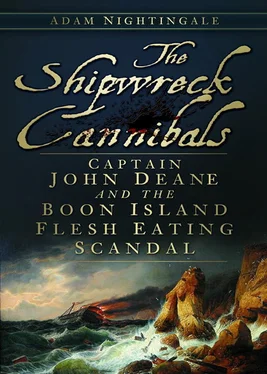The sloop weighed anchor as near to Boon Island’s shore as was safe. It was too dangerous to attempt a landing. The survivors of the Nottingham Galley shouted to the sloop and asked if those on board might help them start a fire. The sloop dispatched a solitary man in a canoe. He brought with him the means to make a fire but that was all. There were no other provisions. When the rescuer saw the survivors at close proximity he was afraid of them, such was their ragged and ghoulish appearance. The crew surrounded him and in unison began to vocalise their joy at finally being discovered. Through the rescuer the crew learned the fate of the Dutchman and his companion. The raft had been found on the shore of the mainland. A single frozen body had been discovered nearby under a tree. The rescuer reasoned that the man in the raft had come ashore during the night and had died because he was ignorant of the area and did not know where to go to find assistance and shelter. The body of the second crew member had not been found and was presumed lost to the sea.
John Deane was supposed to return to the sloop but the canoe overset and Deane fell into the water. It was shallow this time and he was able to wade back to shore. The crew of the Nottingham Galley picked up the canoe and carried it across the island to find a better place for it to return to the sloop. The solitary rescuer stayed with the survivors for three hours. When he left them it was with a promise to return better equipped and get them off the island.
A storm blew up. The sloop struggled to get back to the mainland. The sloop sank. The crew of the sloop made shore by the skin of their teeth. The captain of the sloop sent a communiqué calling for assistance for the men still stranded on Boon Island. For the crew of the Nottingham Galley the force of the storm was leavened by the presence of fire. After almost a month of murderous cold, the heat of the fire must have felt glorious. The carpenter’s flesh certainly tasted better now that it could be broiled.
The bad weather continued throughout the next day. There was no rescue party. That night the men decided to foreswear their ration of cooked flesh. They abstained for fear that if their rescuers came the next morning they might abandon them if it became obvious what the crew of the Nottingham Galley had done to survive. It was a shrewd decision. The following day the rescue party arrived. The survivors could finally go home.
The evacuation from Boon Island was overseen by a Captain Long and a Captain Forbe. The men were transferred from Boon Island to the awaiting vessels. Many had to be carried as the freezing cold had wrought havoc on their limbs and they could not walk. Christopher Langman commended the care and attention shown to the survivors by Captain Forbe and Captain Long. The two captains ensured the survivors were fed but controlled their intake of food. The rescue party arrived at their destination at night. John Deane stayed in lodgings belonging to a Captain Purver. The crew were looked after by the locals. A doctor was assigned to the survivors. Christopher Langman and George White suffered from diarrhoea and fever. The frozen flesh of the cabin boy’s foot had mortified. Part of the foot had to be cut away to stop the gangrene spreading to the rest of the cabin boy’s body. In spite of their terrible afflictions the men were glad to be alive. Christopher Langman praised the care and attention of the locals. He attributed his own and his crewmates’ survival to the ‘goodness of God’.
A few days into the survivors’ convalescence, John Deane wrote his protest. He brought the protest to Christopher Langman and George White to sign. Both men were sick and dependent on the care of the locals for their health and wellbeing. They were physically weak and vulnerable. They didn’t want to sign the protest but were afflicted by a renewed fear of Captain John Deane. Now that he was back on the mainland among his peers and friends, Deane was in a powerful position to exert his influence to Langman and White’s detriment if they refused to comply with his wishes. Both men believed that John Deane would have had them evicted from their lodgings if they failed to endorse his account of the loss of the Nottingham Galley . Langman and White signed the protest.
John Deane’s behaviour on the mainland was cruel and irrational. Deane was the channel through which the relief of the townspeople passed. It was down to Deane to disseminate the relief to the rest of his men. He abused the trust placed in him. He hogged the best of the relief for himself and his brother Jasper. According to Langman, a Captain John Wentworth ‘gave several of our men good clothes,’ but ‘Captain Deane came and ordered them the worst that could be had’. To compound the vicious treatment of his ailing crew, John Deane had his men evicted from their lodgings before they were fully recovered.
John Deane did not seem to be in complete control of his own vindictive moods. Prudence ought to have necessitated that Deane showed a more benevolent side to his friends and deliverers than he did to his crew, but Deane seemed incapable of concealing his cruel nature. He did not exhibit any obvious gratitude for his rescue and he mortally offended his host. While talking with Captain Purver’s children, Deane told them that ‘he would have made a frigasy of them, if he had ’em in Boon Island’. Captain Purver threw his guest out.
Once Christopher Langman, George White and Nicholas Mellan were well enough, each man wrote an affidavit accusing John Deane of fraud and of having perpetrated a violent assault on Langman. On 9 February 1711, in front of their own captain, the three men swore to the veracity of their statements before a justice of the peace.
4
Eighteenth-Century Rashomon
B y 1711 the events of Boon Island had become a talking point in London. It was known that Christopher Langman intended to write an account of the shipwreck exposing John Deane, Jasper Deane and Charles Whitworth to public disgrace. As rumours began to circulate, before anything had yet appeared in print, John and Jasper Deane were already subject to hostile treatment. Charles Whitworth had died shortly after the Boon Island incident and was spared much of the humiliations meted out to his friends. Jasper Deane complained that he and his brother were subject to ‘daily ignominious scandals, and injurious mobbing to our faces’. Necessity demanded that Jasper begin work on his own account of the shipwreck. A race was on to see which of the two factions would get their version of events into print first.
Jasper Deane beat Christopher Langman to the punch. A Narrative of the Sufferings, Preservation and Deliverance of Capt. John Dean: in the Nottingham Galley of London, Cast Away on Boon-Island, near New England, December 11, 1710 was published in the summer of 1711. Jasper Deane’s account was drawn from an expanded narrative written by John Deane from which Jasper ‘omitted many lesser circumstances’ that would ‘swell this narrative beyond its design, and thereby exceed the bounds of common purchase’. Jasper Deane set down what the ‘design’ of his narrative was to be in the introduction to his account:
A few months past. I little expected to appear in print (especially on such occasions) but the frequent enquires of many curious persons (as also the design of others to publish the account without us) seem to lay me under an absolute necessity, lest others acquainted, prejudice the truth with an imperfect relation. Therefore, finding myself obliged to expose this small treatise to public view and censure, I persuade myself that what’s here recorded will be entirely credited, by all candid, ingenious spirits; for those whose kind opinion I am really solicitous.
Читать дальше












